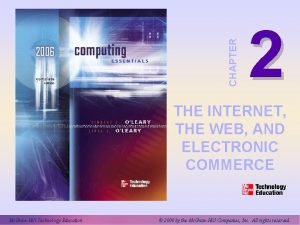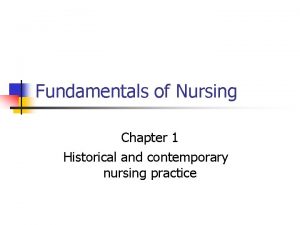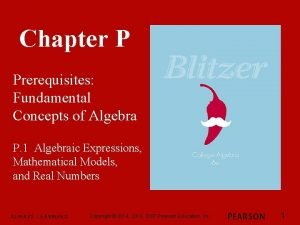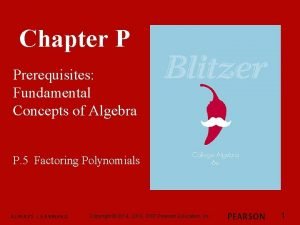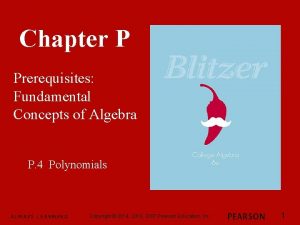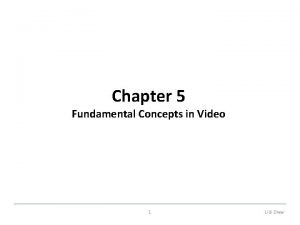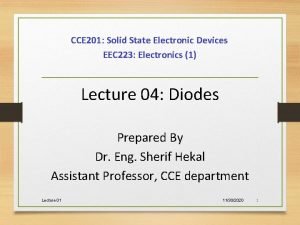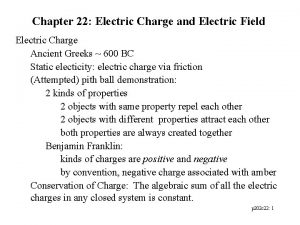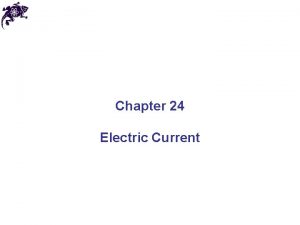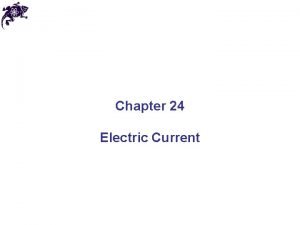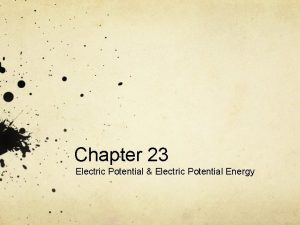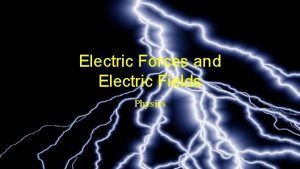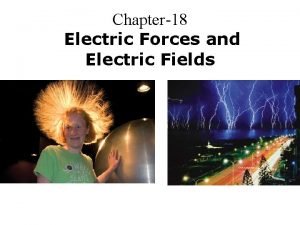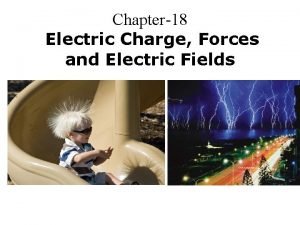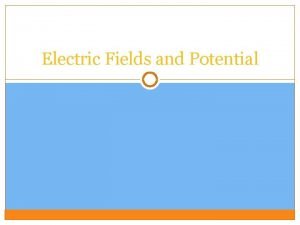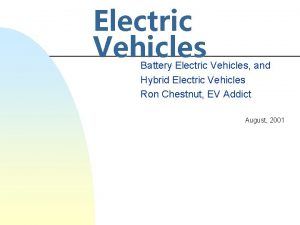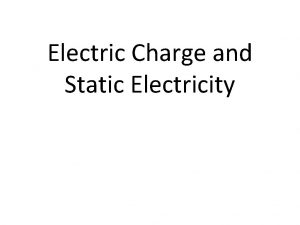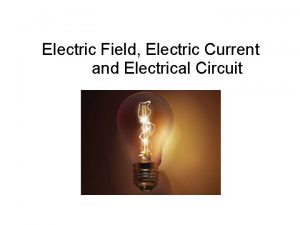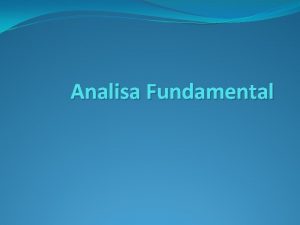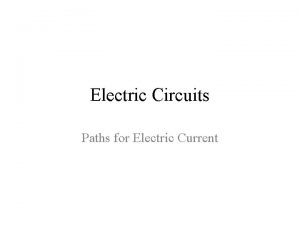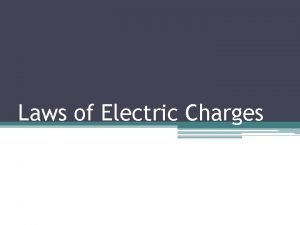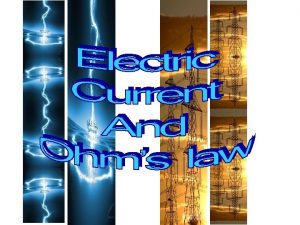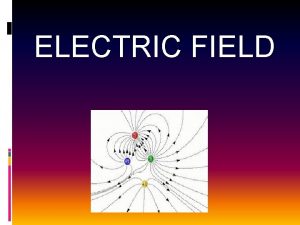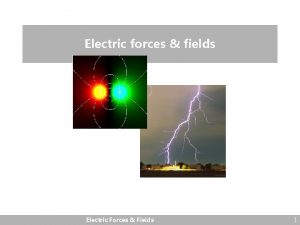Electric and Electronic Technology Chapter 1 Fundamental of























- Slides: 23

Electric and Electronic Technology Chapter 1 – Fundamental of Electric Circuit by Akhtar Razali FKM akhtar@ump. edu. my

Chapter Description • Aims – – – • Expected Outcomes – – • Students able to understand distinguish electric terminologies Understand the principle of electric circuit Understand Kirchoff’s Laws and its applications Understand the Ohm’s law and its application Other related Information – – • Distinguish the elements of electric circuit: nodes, loops, meshes, branches, voltage and current source, power and energy Applying Kirchhoff’s laws to solve simple electric circuits by deriving the related basic equation State and Apply Ohm’s law to electric circuits One of mid semester exam is from this topic No other relevant information be disclosed References – – Rizzoni G. , 2004, Principles and Applications of Electrical Engineering, Revised Fourth Edition, Mc. Graw Hill Hambley A. R. , 2005, Electrical Engineering Principles and Applications, Third Edition, Pearson Prentice Hall

Contents • Distinguish the principal elements of electric circuit: nodes, loops, meshes, branches, voltage and current source, power and energy. • Apply Kirchhoff’s laws to simple electric circuits and derive the basic circuit equations. • State and Apply Ohm’s law to electric circuits

Distinguish the principal elements of electric circuit: nodes, loops, meshes, branches, voltage and current source, power and energy. TOPIC 1

Definition of Electric Circuit • An electric circuit is an interconnection of electrical elements. • A simple electric circuit is shown in Fig. 1. 1. It consists of three basic components: a battery, a lamp, and connecting wires. Such a simple circuit can exist by itself; it has several applications, such as a torch light, a search light, and so forth. Image Source: http: //leakylugnut. com/electronics/basic -electronics/

Definition of Electric Circuit • Another example of electric circuit is shown as in below figure: The circuit consists of Switch, Wire, Battery and Headlamp on a car. • The circuit system can be demonstrated by a schematic diagram as below.

Definition of Electric Circuit • An electrical circuit may consists of various types of circuit element such as power source, resistors, capacitance, inductance and wires/conductors.

Definition of Electric Circuit Direct current or so called DC : when current is constant with time Alternatic current or so called AC: when current is sinusoidal versus time Source: Rizzoni

Definition of Electric Circuit • Figure below shows current flowing in a circuit. Image Source: https: //commons. wikimed ia. org/wiki/File: Ohms_law _voltage_source. svg

Definition of Electric Circuit • Branch • A branch is any portion of a circuit with two terminals connected to it.

Definition of Electric Circuit • Node is an electrical point which two or more circuit elements are joined together Image source: http: //texample. net/tikz/examples/circu itikz/

Definition of Electric Circuit • Loop • A loop is any closed connection of branches.

Definition of Electric Circuit • Loop is any closed connection of branches Image source: http: //latexcookbook. net/cookbook/exa mples/circuits/

Definition of Electric Circuit • A mesh is a loop that does not contain other loops Image source: http: //latexcookbook. net/cookbook/exa mples/circuits/

Kirchhoff's Current Law • Apply Kirchhoff’s laws to simple electric circuits and derive the basic circuit equations

Kirchhoff's Current Law • Kirchoff’s Law: the summation of current flowing in and out of a node is equal to ZERO Image source: https: //commons. wikim edia. org/wiki/File: Kirchh off%27 s_first_law_exam ple. png

Kirchhoff's Voltage Law • Kirchoff’s Voltage Law: The summation of voltages in a mesh is equal to ZERO. Image source: https: //upload. wikimedi a. org/wikipedia/commo ns/4/40/Kirchhoff_volta ge_law. svg

State and Apply Ohm’s law to electric circuits OHM’S LAW

Ohm’s Law • Ohm’s Law id derived from an experiment by Sir Ohm to study relation between voltage, current and resistance. • The findings said voltage is proportional to the current in an ideal resistor.

Electric Power • Electric power is defined as the time rate of expending or absorbing energy measure in watts (W) • It is denoted by an equation of P = VI – P is power – V is voltage – I is current

Sign Convention Passive sign convention states that: The power dissipated by a load is a positive quantity Power dissipated (-) Power generated (+) Power dissipated (+) Power generated (-)

Conclusion of The Chapter • Conclusion #1 – Combination of more than one elements can form an electric circuit. – A point of where many branches/elements are connected together is called a node. • Conclusion #2 – Kirchhoff's Current Law or KCL states the summation of current is a node is equal to ZERO…. – Kirchhoff's Voltage Law or KVL states the summation of current is a mesh is equal to ZERO …. . • Conclusion #3 – Ohm’s Law is the principle equation which KCL and KVL laws are developed.

Akhtar Razali FKM, UMP.
 Chapter 21 electric charge and electric field
Chapter 21 electric charge and electric field Chapter 21 electric charge and electric field
Chapter 21 electric charge and electric field Electric force
Electric force Chapter 21 electric charge and electric field
Chapter 21 electric charge and electric field Electronic field production examples
Electronic field production examples Electric field
Electric field Electric potential electric field
Electric potential electric field Potential energy due to point charges
Potential energy due to point charges Electric charges and electric forces lesson outline
Electric charges and electric forces lesson outline An electronic is the electronic exchange of money or scrip
An electronic is the electronic exchange of money or scrip Latest electronics and information technology in odisha
Latest electronics and information technology in odisha Electric potential from electric field
Electric potential from electric field A suitable electric pump in an electric circuit is a
A suitable electric pump in an electric circuit is a National research university of electronic technology
National research university of electronic technology Chapter 2 the internet the web and electronic commerce
Chapter 2 the internet the web and electronic commerce Chapter 17 section 1 electric charge and force answer key
Chapter 17 section 1 electric charge and force answer key Chapter 16: electric forces and fields answers
Chapter 16: electric forces and fields answers Chapter 33 electric fields and potential
Chapter 33 electric fields and potential Fundamentals of nursing chapter 1 notes
Fundamentals of nursing chapter 1 notes Chapter p prerequisites: fundamental concepts of algebra
Chapter p prerequisites: fundamental concepts of algebra Chapter p prerequisites fundamental concepts of algebra
Chapter p prerequisites fundamental concepts of algebra Chapter p prerequisites
Chapter p prerequisites Secam stands for
Secam stands for Solid state electronic devices 7th solution chapter 4
Solid state electronic devices 7th solution chapter 4














